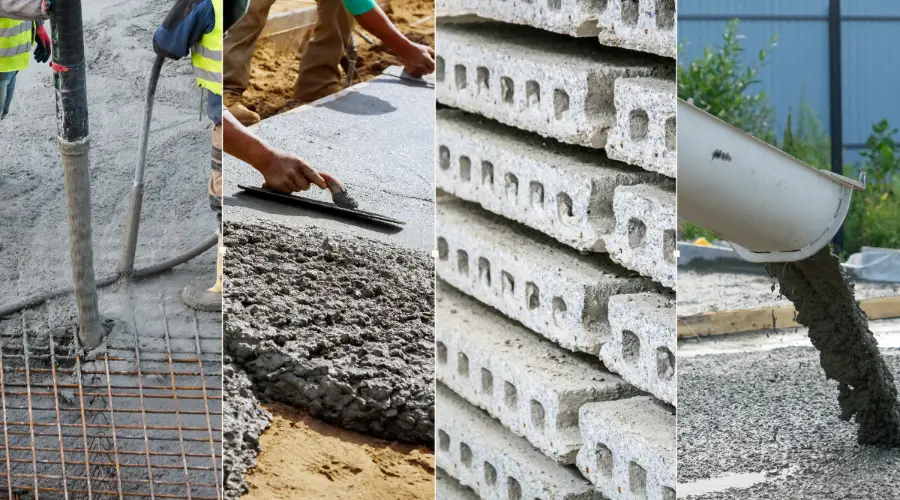Concrete is crucial to construction because it provides the framework and basis for many different types of structures, guaranteeing their stability, strength, and longevity. The foundation for building long-lasting, secure, and functional structures is the installation of concrete. In this blog, we will explore the steps to be followed for laying the concrete as well as the types and tools involved in the laying process.
Steps in the Concrete Laying Process
Step 1: Preparing the Ground
- Site Preparation:
Remove the topsoil, weeds, and stones from the area. Use a spade or rake to prepare and level the ground. While removing soil to the appropriate depth, ensure the base is approximately 75 mm wider than the slab to accommodate the formwork.
- Base Preparation:
Use a compactor, roller, or tamper to compact a hardcore sub-base that has been laid out. To stop moisture loss and dampness problems, cover it with a plastic sheet (damp-proof membrane) and a thin layer of sand.
- Estimate Concrete Requirements:
Determine the approximate amount of concrete needed by using a concrete calculator or by getting in touch with a nearby supplier and providing information such as the area and thickness needed.
Step 2: Formwork Preparation
- Formwork Configuration:
The limit of the slab is made of 25 mm thick hardwood strips that are attached to wooden pegs at 1-meter intervals. Cover the space with plastic sheets and use bricks to support it.
- Establish a Slope (Fall):
In order to allow for water drainage, slope one side of the formwork down a little bit (for example, by 25 mm for each meter).
- Add Joints for Large Spaces:
Use softwood boards (10–12 mm thick) to separate spaces larger than 4 m in any direction. Place a thick strip of bituminous concrete felt between adjacent slabs.
Step 3: Ordering and Laying Concrete Delivery:
- Delivery:
Make arrangements for a ready-mix supplier to deliver the concrete, making sure the vehicle has site access. Set up the workspace and make sure there are enough workers and tools available.
- Spreading and Compacting:
Pour the concrete a little bit higher (10–15 mm) than the finished surface for spreading and compacting. Using a tamping beam, move the concrete in a sawing motion to compact and level it.
Step 4: Finishing and Curing
- Finishing options
For driveways and pathways, a tamped finish is a rough, non-slip surface.
Float Finish: A low-slip, smooth floor and workshop finish.
Steel Float Finish: Exceptionally smooth for ponds and indoor flooring.
Brush Finish: A coarse texture that is appropriate for driveways and paths that is applied before setting.
- Curing Concrete:
To keep the concrete from drying out, cover it with plastic sheeting. Leave a space for air beneath the sheet in chilly temperatures. In winter allow ten days for curing, and in the summer, for seven days.
- Travel Guidelines:
After two days, permit foot travel; after seven days, permit vehicle traffic.
Application of concrete laying
The foundation of contemporary construction, concrete is esteemed for its strength, resilience, and adaptability in a variety of structural and functional uses. It provides outstanding load-bearing capacity and stability, acting as the framework for fundamental components including walls, slabs, columns, and beams. Concrete offers the crucial support and durability required in infrastructure, from high-rise structures that define urban skylines to roads and pavements made to endure heavy traffic. Its use in hydraulic constructions, bridges, and dams further demonstrates its capacity to withstand extreme pressure and water erosion, protecting the integrity and safety of vital projects.
Concrete can be used for a variety of purposes outside of structural ones, such as seawalls to stop erosion in coastal locations, tunnels that must be fireproof, and retaining walls to stop soil erosion as well as surges. While decorative concrete adds visual appeal to both interior and outdoor spaces, pre-cast items like panels and blocks increase construction efficiency. Concrete sound barriers are used in urban design to lessen noise pollution and enhance the quality of life. These many uses highlight how essential concrete is to creating settings that are robust, sustainable, and useful.
Types of Concrete Used in Laying

Depending on the particular needs of the project, different kinds of concrete are utilised in the building. The following are typical varieties of concrete used in laying:
Ready-Mix concrete: This is a pre-mixed concrete that has been delivered to the job site in a clean and readily usable state. It is perfect for big projects and guarantees constant quality.
Reinforced concrete (RC): Concrete and steel bars can be incorporated into it. It is frequently utilised to build floors, roof slabs, and beams in high-rise buildings.
Precast concrete: It is prefabricated. It is used in low- to mid-rise structures, such as office buildings, hotels, and flats. It is perfect for beams, columns, staircases, walls, roofs, and flooring.
High-Performance Concrete: In addition to offering excellent structural strength, it is also a cost-effective solution for building since it can be sized to smaller buildings
Lightweight Concrete: The low density of lightweight concrete is a result of the mixture’s use of lightweight coarse materials like slate, shale, or clay.
Self-Compacting Concrete (SCC): SCC doesn’t need to be vibrated and greatly improves flow ease and rate by using stabilisers and superplasticisers.
Fibre-Reinforced Concrete: Portland cement concrete reinforced with metallic or polymer fibers is commonly referred to as fibre-reinforced concrete. Increased resistance to plastic shrinkage cracking and service-related cracking is one of the fibres’ beneficial properties. Fibres aren’t meant to be the main source of reinforcement; they are added as the concrete is being formed.
Pervious Concrete: It cools the concrete surface by allowing moisture from underneath to evaporate. Pervious concrete doesn’t absorb as much heat from the sun since it has less thermal mass. Furthermore, it doesn’t retain or absorb a lot of heat.
Air-Entrained Concrete: In it, tiny air bubbles improve its resistance to freeze-thaw, making it appropriate for cold climates and frost-prone regions.
Polymer Concrete: Concrete that substitutes a polymer for lime-type cement as a binder is known as polymer concrete. Epoxy granite is one particular kind in which just epoxy is utilised as a polymer.
Tools and Equipment Needed for Concrete Laying

A range of instruments are needed for concrete laying to guarantee a precise, timely, and long-lasting construction. Each instrument is essential from mixing to finishing. For structural integrity, a constant mixture of cement, water, sand, and gravel is ensured using concrete mixers. Bull floats smooth out the surface and remove imperfections, while screeds level and smooth freshly poured concrete. Vibrators eliminate air pockets to increase density and strength, while plate compactors stabilise the base material to provide a firm foundation. Rebar cutters and benders prepare reinforcement for larger constructions, while hand instruments like shovels and wheelbarrows help with material handling. Structural problems are avoided by using precise instruments like laser levels to guarantee an even surface.
Aluminium or magnesium trowels are used to finish and smooth the surface, and curing chemicals are used with sprayers, aiding in moisture retention for appropriate curing. Workers are protected by safety equipment including steel-toed boots and gloves, and finishing brooms give outdoor concrete textured, non-slip surfaces. Modern tools like power chisels increase productivity, while power tools like drills and saws allow for exact adjustments. Using the proper tools guarantees quality, safety, and longevity when laying concrete, regardless of the size of the job.
Conclusion
Concrete constructions are made to support a wide range of stresses and environmental factors, such as exposure to seawater, freezing salts, sulfate-rich soils, scratching, and wet-dry cycles. The structural loads and environmental conditions that the concrete will experience determine the mix proportions and material selection. Concrete structures exhibit remarkable strength and durability during their lifetime when they are correctly designed and built.
FAQ’s
A binder, usually cement, rough and fine aggregates, mainly sand and stone, and water makes up concrete, a composite material. These are the components that makeup concrete.
Concrete is used in structures, foundations, roads, bridges, dams, tunnels, coastal protection, retaining walls, decorative projects, precast elements, and noise barriers for durability and strength.

